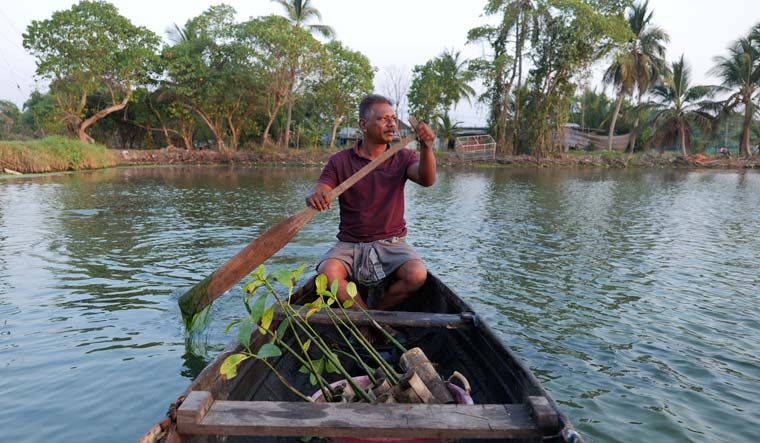‘Mangrove Man’ Fights To Save Sinking Shores
Apr 19, 2023 | Pratirodh Bureau
T. P. Murukesan rows a canoe stocked with mangrove saplings along a water body off the shores of Vypin Island in Kochi, Kerala (Image: AP)
Source: PTI
On the receding shorelines of low-lying Vypin Island off Kerala’s coast, T. P. Murukesan fixed his eyes on the white paint peeling off the damp walls of his raised home and recounted the most recent floods.
“The floods are occurring more frequently and lasting longer,” he said. The last flood was chest-high for his young grandson. “Every flood brings waters this high, we just deal with it.”
Sea level rise and severe tidal floods have forced many families in Murukesan’s neighborhood to relocate to higher grounds over the years. But the retired fisherman has almost single-handedly been buffering the impacts of the rising waters on his home and in his community.
Known locally as “Mangrove Man,” Murukesan has turned to planting the trees along the shores of Vypin and the surrounding areas in the Kochi region of Kerala state to counter the impacts of rising waters on his home.
Tidal flooding occurs when sea level rise combines with local factors to push water levels above the normal levels. Mangroves can provide natural coastal defenses against sea level rise, tides and storm surges, but over the course of his life forest cover in the state has dwindled.
Murukesan said he grew up surrounded by beautiful, abundant mangroves that separated islands from the sea. Now, only fragmented patches of mangroves can be seen in Kochi, the state’s financial capital.
“They protected our houses against floods, sea erosion, and storms, used to be an inseparable part of our life, our ecosystem,” he said. “Only these can save us.”
Murukesan said he has planted over 1,00,000 mangroves. He plants saplings on alternate days and does most of the work himself. Some help comes in the form of saplings from the M S Swaminathan Research Foundation, a non-government organisation based in Chennai.
His efforts come up against a strong trend in the opposite direction.
Ernakulam district, which includes Kochi, has lost nearly 42 per cent of its mangrove ecosystems, including major decreases in the southern Puthuvypeen area in Vypin, according to a study released last year by the Indian Space Research Organisation (ISRO) and the Kerala University of Fisheries and Ocean Studies.
Mangrove cover in the state has reduced from 700 square kilometres to just 24 square kilometres since 1975, according to the Kerala Forest department.
“The construction of coastal roads and highways has severely damaged mangrove ecosystems in the state,” said K K Ramachandran, former member secretary of the Kerala Coastal Zone Management Authority, a government body mandated to protect the coastal environment. “There should be an incentive for people who are making efforts to protect them.”
Murukesan’s dedication to the cause has won him praise, awards and the audience of senior politicians but not incentives beyond the immediate benefits to his home.
He said the mangroves he planted in and around the area in 2014 have grown into a dense thicket and are helping reduce the intensity of tidal flooding, but he’s nevertheless continuing his efforts.
Despite the thousands of new mangrove trees, other factors like climate change mean tidal floods have become more frequent and severe, sometimes keeping children from going to school and people from getting to work. It’s all mentally exhausting, Murukesan and his wife, Geetha, said.
“I have to travel a lot to collect seeds. My wife helps me in the nursery as much as she can. I am tired but I cannot stop,” he said.
Geetha said they do the tough work “for our children,” preserving the forest for decades to come.
“It keeps us going,” she said.
Vypin is at high-risk for tidal flooding, said Abhilash S, director of the Advanced Centre for Atmospheric Radar Research at the Cochin University of Science and Technology.
“The sea level has risen and has damaged freshwater supplies. Sea erosion and spring tides have worsened. Coastal flooding is a common occurrence now,” he said. “The carrying capacity of the backwaters has reduced due to sediment deposition and encroachment, and the rainwater enters residential areas during the monsoon season.”
Backwaters in Kerala are networks of canals, lagoons and lakes parallel to coastal areas, unique ecosystems that help provide a buffer to rising sea levels.
According to the World Meteorological Organization, global mean sea level rose by 4.5 millimetres per year between 2013 and 2022. It’s a major threat for countries like India, China, the Netherlands and Bangladesh, which comprise large coastal populations.
NASA projections show that Kochi might experience a sea level rise of 0.22 metres by 2050, and over half a meter by 2100 in a middle-of-the-road climate-warming scenario.
“Many families have left,” Murukesan said.
Fishing families living within 50 metres of the shore get a financial assistance of Rs 10 lakh through a rehabilitation scheme run by the Kerala government. Only few of those not covered under it have means to relocate to safer places.
Some fishing families shift to government shelters in the monsoon season and return after it ends. A few have built stilt houses that stand on columns to fight tidal floods.
Murukesan knows the sea is rising, but it’s the backwaters that make him more anxious. The backwaters have become shallow due to the silt deposited by heavy floods. During heavy rain events, the water inundates the island.
“We are caught between the sea and the backwaters. They are likely to swallow the island in some years, but I am not going anywhere,” Murukesan said. “I was born here, and I will die here.”
